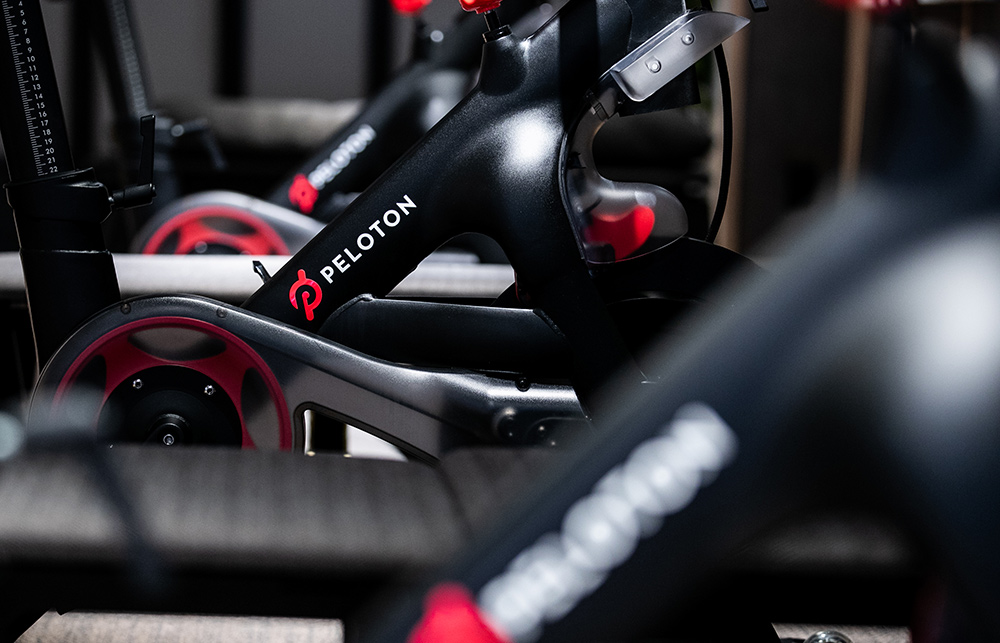“类假日”需求看涨,助推健身公司股价走高

受疫情影响,人们近来纷纷居家锻炼身体,这确实让Peloton获益。
Peloton主要生产健身自行车、跑步机,提供社交媒体上广受欢迎的健身课程(和教练),这家室内健身公司正处于快速发展期。今年到目前为止,公司股价上涨超过80%,而标准普尔指数今年以来仍落后约5%。一些华尔街人士看好这家健身公司,认为其可能仍存在发展空间。
Stifel的分析师刚刚将Peloton的目标价格从每股55美元上调至62美元(华尔街最高目标价),因为他们看涨该股,认为Peloton将继续受益于“消费者行为的转变、健身房关闭/社交隔离,以及口碑带来的稳定需求”。分析师写道:事实上,我们认为这些利好因素“有可能推动多个季度的类假日需求,同时我们预计利润率增长会多往后延续两到三年。”本周一午盘,Peloton的股价飙升逾7%。新的目标价格意味着该股将上涨超过13%。
尽管该公司的产品价格高昂(一辆健身自行车的售价约为2,245美元),但在居家隔离令实施期间,这些产品却成了一些健身爱好者订购的主要产品。Peloton最近收获超过100万名健身相关用户(公司在3月将其数字订阅的免费试用期从1个月延长到3个月)。尽管很多消费者可能会在经济不确定时期勒紧裤腰带,但Peloton增长最快的产品消费群体,其家庭收入在75,000美元以下。
同时,分析师对可能低于预期的Peloton健身相关订阅的退订率持乐观态度,并且注意到其应用业务最近在国际市场也大幅增长,在英国展现出“非凡的实力”。Stifel的分析师预测会出现“季节性上涨”,将第三季度总收入的(季度环比)增长率预期提高为–16%(年同比依然上涨100%),高于华尔街的预测值–25%。
然而,受益于居家健身潮流的公司并不只有Peloton一个。在社交隔离健身领域,竞争也在升温,比如家用划船机初创公司Hydrow和居家举重训练初创公司Tempo也越来越受欢迎。由于新冠疫情迫使许多健身爱好者走出健身房,回到家中,因此人们对(昂贵的)家用健身器材和健身课程的需求似乎也有所增加。Hydrow表示,4月的销售额比1月增长了400%,该公司的器材零售价为2,199美元。而最近有消息人士告诉《财富》杂志,Tempo(其健身系统的费用为1,995美元)筹集了约6,000万美元的资金(尚未完成)。
Hydrow等公司正打算对Peloton的成功发起直接挑战。Hydrow的首席执行官布鲁斯•史密斯最近在接受《财富》杂志采访时说:在居家健身领域,“我认为会出现四五个赢家。”
另外,随着各州重新开放经济社会活动,健身房也随之重开。大多数健身房都在缩减接待容量,但健身爱好者可能不想永远独自健身。不过,Stifel的分析师认为,大型健身品牌(如Gold’s Gym和24 Hour Fitness,已经根据美国破产法第11章申请了破产保护)的规模缩减,是推动Peloton发展的另一个积极因素。
除了上调价格目标外,Stifel的分析师还上调了未来12个月的订户和交付预期,预计营收将增长4%以上。(财富中文网)
译者:Biz
受疫情影响,人们近来纷纷居家锻炼身体,这确实让Peloton获益。
Peloton主要生产健身自行车、跑步机,提供社交媒体上广受欢迎的健身课程(和教练),这家室内健身公司正处于快速发展期。今年到目前为止,公司股价上涨超过80%,而标准普尔指数今年以来仍落后约5%。一些华尔街人士看好这家健身公司,认为其可能仍存在发展空间。
Stifel的分析师刚刚将Peloton的目标价格从每股55美元上调至62美元(华尔街最高目标价),因为他们看涨该股,认为Peloton将继续受益于“消费者行为的转变、健身房关闭/社交隔离,以及口碑带来的稳定需求”。分析师写道:事实上,我们认为这些利好因素“有可能推动多个季度的类假日需求,同时我们预计利润率增长会多往后延续两到三年。”本周一午盘,Peloton的股价飙升逾7%。新的目标价格意味着该股将上涨超过13%。
尽管该公司的产品价格高昂(一辆健身自行车的售价约为2,245美元),但在居家隔离令实施期间,这些产品却成了一些健身爱好者订购的主要产品。Peloton最近收获超过100万名健身相关用户(公司在3月将其数字订阅的免费试用期从1个月延长到3个月)。尽管很多消费者可能会在经济不确定时期勒紧裤腰带,但Peloton增长最快的产品消费群体,其家庭收入在75,000美元以下。
同时,分析师对可能低于预期的Peloton健身相关订阅的退订率持乐观态度,并且注意到其应用业务最近在国际市场也大幅增长,在英国展现出“非凡的实力”。Stifel的分析师预测会出现“季节性上涨”,将第三季度总收入的(季度环比)增长率预期提高为–16%(年同比依然上涨100%),高于华尔街的预测值–25%。
然而,受益于居家健身潮流的公司并不只有Peloton一个。在社交隔离健身领域,竞争也在升温,比如家用划船机初创公司Hydrow和居家举重训练初创公司Tempo也越来越受欢迎。由于新冠疫情迫使许多健身爱好者走出健身房,回到家中,因此人们对(昂贵的)家用健身器材和健身课程的需求似乎也有所增加。Hydrow表示,4月的销售额比1月增长了400%,该公司的器材零售价为2,199美元。而最近有消息人士告诉《财富》杂志,Tempo(其健身系统的费用为1,995美元)筹集了约6,000万美元的资金(尚未完成)。
Hydrow等公司正打算对Peloton的成功发起直接挑战。Hydrow的首席执行官布鲁斯•史密斯最近在接受《财富》杂志采访时说:在居家健身领域,“我认为会出现四五个赢家。”
另外,随着各州重新开放经济社会活动,健身房也随之重开。大多数健身房都在缩减接待容量,但健身爱好者可能不想永远独自健身。不过,Stifel的分析师认为,大型健身品牌(如Gold’s Gym和24 Hour Fitness,已经根据美国破产法第11章申请了破产保护)的规模缩减,是推动Peloton发展的另一个积极因素。
除了上调价格目标外,Stifel的分析师还上调了未来12个月的订户和交付预期,预计营收将增长4%以上。(财富中文网)
译者:Biz
Working out during the pandemic certainly seems to be working out for Peloton.
The indoor fitness company that produces stationary bikes, treadmills, and social-media-famous fitness classes (and instructors) is enjoying quite a run. The company’s stock is up over 80% year to date, while the S&P still lags about 5% for the year. And some on the Street are bullish the fitness company may still have room to ride.
Analysts at Stifel just raised Peloton’s price target from $55 to $62—a Street high—on bullishness that Peloton would continue to benefit from “shifting consumer behavior, gym closures/social contact avoidance, and steady demand from word-of-mouth.” In fact, those tailwinds “have the potential to fuel multiple quarters of holiday-like demand in our view, while also pulling forward the margin expansion path by two to three years in our expectations,” analysts wrote. Peloton’s stock popped over 7% in midday trading Monday. The new price target implies an over 13% rally in the stock.
The company has become a pandemic staple for some fitness enthusiasts amid shelter-in-place orders, despite the steep price tag (a bike goes for about $2,245). The fitness company topped 1 million connected-fitness subscribers recently (the company extended its free trial of its digital subscription from one to three months in March), and although many consumers are likely tightening their belts amid the economic uncertainty, Peloton’s fastest-growing demographic for product sales earns under $75,000 per household.
Meanwhile, analysts are optimistic about the likely lower-than-expected churn rate for Peloton’s connected fitness subscriptions, and note its app has seen a boost in international markets lately too, with “exceptional strength” in the U.K. And Stifel analysts are predicting “seasonal upside,” increasing total revenue estimates to –16% (quarter over quarter) for the September quarter (still up 100% year over year), ahead of the Street forecasts of –25%.
However, Peloton isn’t riding the wave of at-home fitness trends alone. Competition is also heating up in the socially distanced workout space, as those like Hydrow, an at-home rowing startup, and Tempo, an at-home weights training startup, gain traction. As the pandemic has forced many fitness enthusiasts out of their gyms and into their homes, the demand for (pricey) at-home equipment and classes seems to have increased. Hydrow, whose machines retail at $2,199, says sales have risen 400% in April compared with January, while sources recently told Fortune that Tempo (whose system costs $1,995) raised some $60 million in funding (yet to close).
And those like Hydrow are aiming to challenge Peloton’s success directly. “I think there will be four or five winners,” Hydrow CEO Bruce Smith recently told Fortune of the at-home fitness space.
What’s more, as states reopen, gyms are reopening with them. Most gyms are operating at reduced capacity, but it’s likely fitness enthusiasts won’t want to work out alone forever. Still, analysts at Stifel see the downsizing of big gym brands (like Gold’s Gym and 24 Hour Fitness, which also filed for Chapter 11 bankruptcy) as another positive driver for Peloton.
In addition to raising the price target, analysts at Stifel also raised the next 12 months’ subscriber and delivery estimates, anticipating 4% higher revenues.













